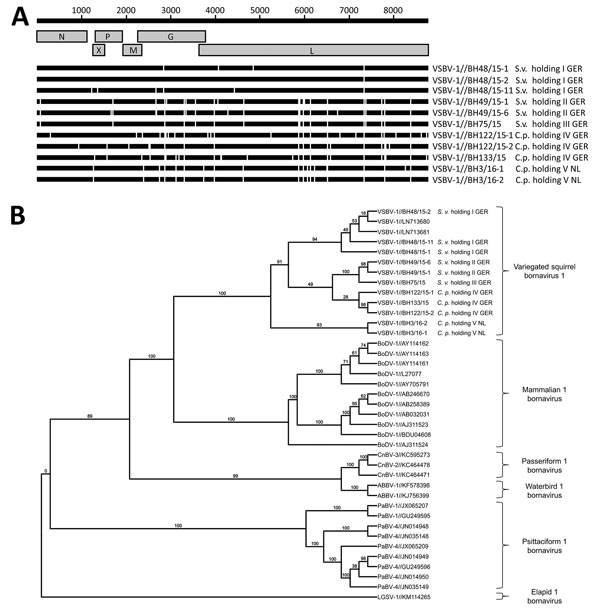Variegated Squirrel Bornavirus 1 in Squirrels, Germany and the Netherlands
Kore Schlottau, Maria Jenckel, Judith van den Brand, Christine Fast, Christiane Herden, Dirk Höper, Timo Homeier-Bachmann, Jens Thielebein, Niels Mensing, Bert Diender, Donata Hoffmann, Rainer G. Ulrich, Thomas C. Mettenleiter, Marion Koopmans, Dennis Tappe, Jonas Schmidt-Chanasit, Chantal B.E.M. Reusken, Martin Beer

, and Bernd Hoffmann
Author affiliations: Friedrich-Loeffler-Institut, Greifswald-Insel Riems, Germany (K. Schlottau, M. Jenckel, C. Fast, D. Höper, T. Homeier-Bachmann, D. Hoffmann, R.G. Ulrich, T.C. Mettenleiter, M. Beer, B. Hoffmann); Erasmus Medical Center, Rotterdam, the Netherlands (J. van den Brand, M. Koopmans, C.B.E.M. Reusken); Justus-Liebig University Gießen, Gießen, Germany (C. Herden); Martin Luther University Halle-Wittenberg, Halle, Germany (J. Thielebein); Tierarztpraxis Dr. Niels Mensing, Magdeburg, Germany (N. Mensing); Dierenartspraktijk Diender, Vlissingen, the Netherlands (B. Diender); Bernhard Nocht Institute for Tropical Medicine, Hamburg, Germany (D. Tappe, J. Schmidt-Chanasit)
Main Article
Figure 2

Figure 2. Analysis of 11 newly identified VSBV-1 genomes from squirrels collected in Germany and the Netherlands, 2015, in comparison with related bornaviruses. A) New sequences aligned with published squirrel-derived VSBV-1 genome (GenBank accession no. LN713680). The upper black bar indicates the reference sequence; gray boxes depict the genome. White bar sections for each animal sequence indicate nucleotide variations. The new sequences show 1–29 nucleotide differences compared to the published prototype sequence. G, glycoprotein; L, large structural protein; M, matrix; N, nucleoprotein; P, phosphoprotein; X, nonstructural protein. B) Phylogenetic tree of VSBV-1 isolates from this study (labeled) and comparison sequences. Tree was constructed using the maximum-likelihood method. Numbers along branches are bootstrap values. GER, Germany; NL, the Netherlands; VSBV-1, variegated squirrel bornavirus 1.
Main Article
Page created: February 17, 2017
Page updated: February 17, 2017
Page reviewed: February 17, 2017
The conclusions, findings, and opinions expressed by authors contributing to this journal do not necessarily reflect the official position of the U.S. Department of Health and Human Services, the Public Health Service, the Centers for Disease Control and Prevention, or the authors' affiliated institutions. Use of trade names is for identification only and does not imply endorsement by any of the groups named above.
